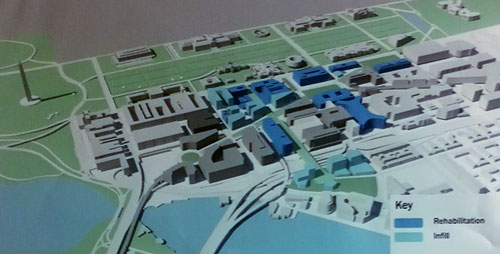Southwest Ecodistrict looks to fix ‘60s planning failure

Forrestal Building blocking the view of the Smithsonian Castle along 10th Street. Photo by M.V. Jantzen on Flickr.
The area along 10th Street in Southwest is now little more than a desolate heat island of bland federal buildings where few dare to tread after 5 pm. The Southwest Ecodistrict project seeks to change this by radically remaking this neighborhood into a vibrant place and a national showcase for sustainable development.
The National Capital Planning Commission (NCPC) and DC Office of Planning are leading the project. In 2 public meetings thus far, the agencies have thus far been tight-lipped about just how they’d go about retooling many of the drab brutalist buildings along 10th Street SW into beacons of sustainability.
Last night, they introduced three proposals on how to shape sustainable development in the coming years. The three proposals, dubbed Rehabilitation, Redevelopment, and Repurpose, take different approaches to creating a more sustainable corridor.
Regardless of the final path that future development will take in the neighborhood, all three proposals would deck the CSX rail line to extend Maryland Avenue SW, include some degree of infill development, and vastly improve the connection between Benjamin Banneker Park and the Southwest Waterfront.
Rehabilitation
Under the Rehabilitation proposal, future development of the Ecodistrict would focus on retooling the vastly inefficient 60’s and 70’s era federal buildings that currently dominate the site. This would primarily involve a vast upgrade of the heating and cooling systems present in many of these buildings, enhancing stormwater management, and increasing on-site electricity production and conservation.
Some of the buildings may also start to incorporate residential and commercial uses in order to enhance the diversity of the neighborhood. While no buildings would be removed under this option, it would cut away the Department of Energy’s overhang that currently cuts off views along 10th Street of the Smithsonian Castle to the north.
Furthermore, it would enhance the current network of streets by adding a number of new intersections and enhancing the neighborhood’s connectivity.
Redevelopment
The Redevelopment proposal includes many of the elements of Rehabilitation, such as the energy-efficiency and stormwater elements, but it goes a farther in some key respects. Instead of just cutting out the 10th Street overhang, this plan would completly demolish the Department of Energy’s James Forrestal building, replacing it with a number of new structures.
The great appeal of this plan is that it will open up brand new views of the Washington Monument from Virginia Avenue SW. The plan also seeks to deck over a portion of I-395 between 10th Street and 9th Street, increasing the number of potential buildings along the corridor and partially removing the unsightly highway from view.
This Redevelopment proposal also goes the farthest to enhance the connectivity of the street grid by breaking up the Department of Energy superblock and adding the greatest number of new intersections to the neighborhood.
Repurpose
NCPC’s final proposal is the simplest. It focuses on repurposing several federal buildings to new uses. The buildings with the most potential include the nearby US Postal Services Library, the General Services Administration Building, and the FAA’s Orrville Wright Building.
NCPC believes that simply repurposing these buildings and renovating others to more efficiently use their space could yield up to another million square feet of space in which to add neighborhood amenities.
No plan has been set in stone, and any future development will likely include bits and pieces from any or all of these proposals. All seek to enhance the neighborhood by adding new amenities, including restaurants, retail, and cultural destinations that will not only draw new residents to the area but also pull some of the millions of tourists away from the National Mall and towards the cultural amenities of our fair city.




